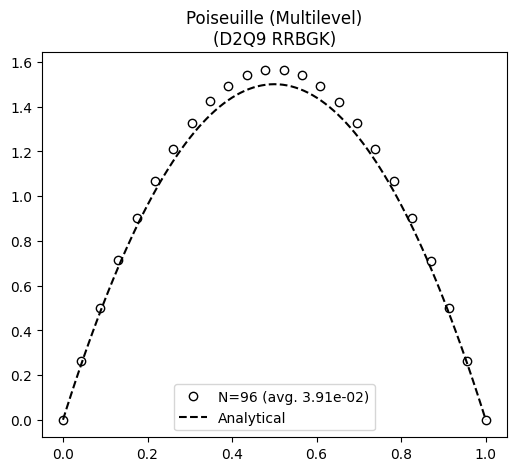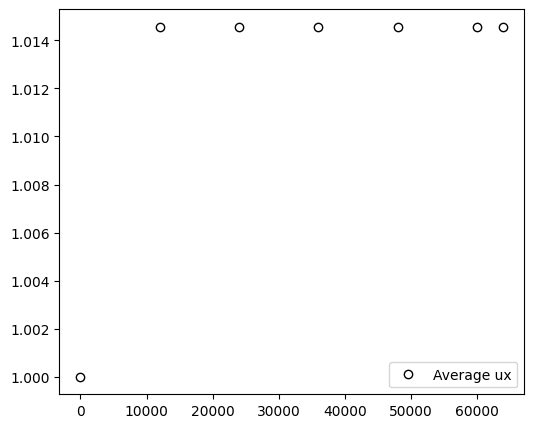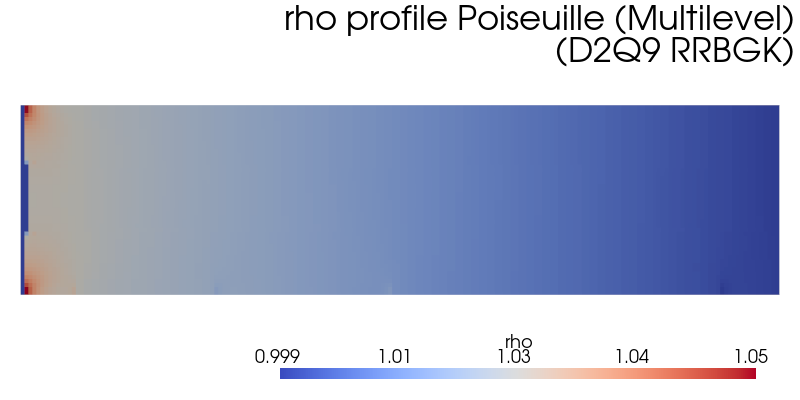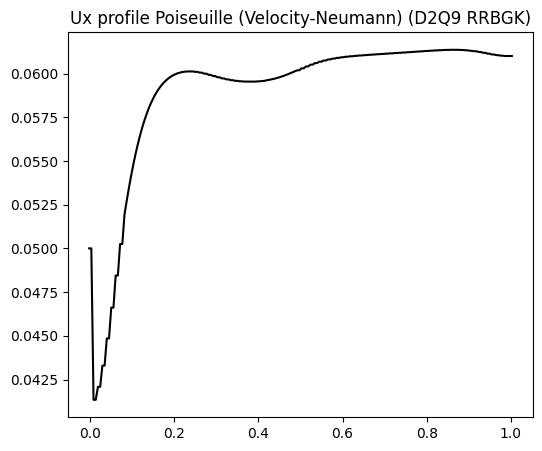Poiseuille Channel (Multilevel)#
In this simulation, the multilevel approach is tested to check the macroscopics continuity when passing through different levels and when applied at boundary regions of the computational domain.
from nassu.cfg.model import ConfigScheme
filename = "tests/validation/cases/02_poiseuille_channel_flow.nassu.yaml"
sim_cfgs = ConfigScheme.sim_cfgs_from_file_dct(filename)
In this case, a small value for the relaxation time \(\tau\) was adopted. Since the aim is to check possible discontinuities in the multilevel formulation, less stable values of \(\tau\) could highlight implementation issues.
sim_cfg = next(
sim_cfg
for (name, _), sim_cfg in sim_cfgs.items()
if name == "velocityNeumannPoiseuilleChannelMultilevel"
)
Extract data from multiblock data from output file of macrs export
import numpy as np
from vtk.util.numpy_support import vtk_to_numpy
from tests.validation.notebooks import common
extracted_data = {}
array_to_extract = "ux"
export_instantaneous_cfg = sim_cfg.output.instantaneous
macr_export = export_instantaneous_cfg["default"]
time_step = macr_export.time_steps(sim_cfg.n_steps)[-1]
reader = macr_export.read_vtm_export(time_step)
p1 = [sim_cfg.domain.domain_size.x * 0.75, 0.5, 0]
p2 = [sim_cfg.domain.domain_size.x * 0.75, sim_cfg.domain.domain_size.y - 0.5, 0]
line = common.create_line(p1, p2, sim_cfg.domain.domain_size.y - 1)
# Get the points from the vtkLineSource
polyData = line.GetOutput()
points = polyData.GetPoints()
pos = np.linspace(p1, p2, sim_cfg.domain.domain_size.y)
probe_filter = common.probe_over_line(line, reader.GetOutput())
probed_data = vtk_to_numpy(probe_filter.GetOutput().GetPointData().GetArray(array_to_extract))
extracted_data[(sim_cfg.sim_id, sim_cfg.name)] = {"pos": pos, "data": probed_data}
extracted_data.keys()
dict_keys([(0, 'velocityNeumannPoiseuilleChannelMultilevel')])
Extract data from multiblock data from output file of macrs export for rho plotting
average_data = {}
array_to_extract = "rho"
for time_step in macr_export.interval.get_all_process_steps(sim_cfg.n_steps):
reader = macr_export.read_vtm_export(time_step)
multiblock_dataset = reader.GetOutput()
n_blocks = multiblock_dataset.GetNumberOfBlocks()
blocks_data = []
for i in range(n_blocks):
block = multiblock_dataset.GetBlock(i)
data_array = vtk_to_numpy(block.GetCellData().GetArray(array_to_extract))
blocks_data.append(data_array)
multiblock_avg = np.average(np.concatenate(blocks_data).flatten())
average_data[(sim_cfg.sim_id, sim_cfg.name, time_step)] = multiblock_avg
average_data
{(0, 'velocityNeumannPoiseuilleChannelMultilevel', 0): np.float32(1.0),
(0,
'velocityNeumannPoiseuilleChannelMultilevel',
12000): np.float32(1.0145637),
(0,
'velocityNeumannPoiseuilleChannelMultilevel',
24000): np.float32(1.0145637),
(0,
'velocityNeumannPoiseuilleChannelMultilevel',
36000): np.float32(1.0145637),
(0,
'velocityNeumannPoiseuilleChannelMultilevel',
48000): np.float32(1.0145637),
(0,
'velocityNeumannPoiseuilleChannelMultilevel',
60000): np.float32(1.0145637),
(0,
'velocityNeumannPoiseuilleChannelMultilevel',
64000): np.float32(1.0145637)}
Extract data from multiblock data from output file of macrs export for profile plotting
profile_data = {}
array_to_extract = "ux"
time_step = macr_export.time_steps(sim_cfg.n_steps)[-1]
reader = macr_export.read_vtm_export(time_step)
# p1 = [0.5, sim_cfg.domain.domain_size.y / 2 - 0.5, bounds_z[0]]
# p2 = [sim_cfg.domain.domain_size.x - 0.5, sim_cfg.domain.domain_size.y / 2 - 0.5, bounds_z[1]]
# line = create_line(p1, p2, sim_cfg.domain.domain_size.x - 1)
p1 = [0.25, sim_cfg.domain.domain_size.y / 2, 0]
p2 = [sim_cfg.domain.domain_size.x - 0.25, sim_cfg.domain.domain_size.y / 2, 0]
line = common.create_line(p1, p2, 2 * sim_cfg.domain.domain_size.x - 1)
# Get the points from the vtkLineSource
polyData = line.GetOutput()
points = polyData.GetPoints()
pos = np.linspace(p1, p2, sim_cfg.domain.domain_size.x * 2)
probe_filter = common.probe_over_line(line, reader.GetOutput())
probed_data = vtk_to_numpy(probe_filter.GetOutput().GetPointData().GetArray(array_to_extract))
profile_data[(sim_cfg.sim_id, sim_cfg.name)] = {"pos": np.array(pos), "data": probed_data}
profile_data.keys()
dict_keys([(0, 'velocityNeumannPoiseuilleChannelMultilevel')])
Results#
The velocity profile at the end of simulation is compared with the steady state analytical solution below:
Processing functions for Poiseuille Flow case
from typing import Callable
def get_poiseuille_analytical_func() -> Callable:
"""Poiseuille analytical velocity function
Returns:
Callable: Analytical velocity function
"""
return lambda pos: 6 * (pos - pos**2)
def plot_analytical_poiseuille_vels(ax):
x = np.arange(0, 1.01, 0.01)
analytical_func = get_poiseuille_analytical_func()
analytical_data = analytical_func(x)
ax.plot(x, analytical_data, "--k", label="Analytical")
import matplotlib.pyplot as plt
fig, ax = plt.subplots()
fig.set_size_inches(6, 5)
style_num = ["o", "^", "s", "+", "x"]
num_data = extracted_data[(sim_cfg.sim_id, sim_cfg.name)]
num_avg_vel = np.average(num_data["data"])
position_vector = (num_data["pos"][:, 1] - 0.5) / (sim_cfg.domain.domain_size.y - 1)
ax.plot(
position_vector,
num_data["data"] / num_avg_vel,
style_num[0],
label=f"N={sim_cfg.domain.domain_size.x} (avg. {num_avg_vel:.2e})",
fillstyle="none",
c="k",
)
plot_analytical_poiseuille_vels(ax)
ax.set_title(
f"Poiseuille (Multilevel)\n({sim_cfg.models.LBM.vel_set} {sim_cfg.models.LBM.coll_oper})"
)
ax.legend()
plt.show(fig)

No discontinuities issues are seen through the velocity profile, indicating a satisfactory implementation.
fig, ax = plt.subplots()
fig.set_size_inches(6, 5)
plotting_data: list[float] = []
axis_data: list[int] = []
for (_, _, timestep), average_val in average_data.items():
plotting_data.append(average_val)
axis_data.append(timestep)
ax.plot(axis_data, plotting_data, "ok", label=f"Average {array_to_extract}", fillstyle="none")
ax.legend()
plt.show(fig)

The average pressure sustains the convergence aspect exhibited in the single level simulation, though it takes longer to converge since a smaller value of \(\tau\) was adopted.
import pyvista as pv
array_to_inspect = "rho"
plotter = pv.Plotter(window_size=(800, 400))
time_step = macr_export.time_steps(sim_cfg.n_steps)[-1]
multiblock_file = macr_export.time_step_filename(time_step, ".vtm")
mesh = pv.read(multiblock_file)
mesh.set_active_scalars(array_to_inspect)
plotter.add_mesh(mesh, cmap="coolwarm")
plot_title = f"{array_to_inspect} profile Poiseuille (Multilevel)\n({sim_cfg.models.LBM.vel_set} {sim_cfg.models.LBM.coll_oper})"
plotter.add_text(plot_title, position="upper_right", font_size=18, color="black")
plotter.camera_position = [(48.0, 12.0, -192.16548199848856), (48.0, 12.0, 1.0), (0.0, -1.0, 0.0)]
plotter.camera.zoom(2)
plotter.show(jupyter_backend="static")
# plotter.show(jupyter_backend='static', cpos="xy", return_cpos=True) # Trick to get automatically the camera position

The general flow’s density profile shown above presents no visible disconuity.
fig, ax = plt.subplots()
fig.set_size_inches(6, 5)
num_data = profile_data[(sim_cfg.sim_id, sim_cfg.name)]
position_vector = (num_data["pos"][:, 0] - 0.5) / (sim_cfg.domain.domain_size.x - 1)
ax.plot(position_vector, num_data["data"], c="k")
ax.set_title(
f"Ux profile Poiseuille (Velocity-Neumann) ({sim_cfg.models.LBM.vel_set} {sim_cfg.models.LBM.coll_oper})"
)
plt.show(fig)

The centerline velocity has an asympotic profile. However, it would take a longer length for the velocity to completely stabilizes.
Version#
sim_info = sim_cfg.output.read_info()
nassu_commit = sim_info["commit"]
nassu_version = sim_info["version"]
print("Version:", nassu_version)
print("Commit hash:", nassu_commit)
Version: 1.6.33
Commit hash: fbc0edb5260d2734f0a290e1806c26ac6d865ff4
Configuration#
from IPython.display import Code
Code(filename=filename)
simulations:
- name: periodicPoiseuilleChannel
save_path: ./tests/validation/results/02_poiseuille_channel_flow/periodic
n_steps: !unroll [250, 1000, 4000, 16000]
report:
frequency: 1000
domain:
domain_size:
x: !unroll [4, 8, 16, 32]
y: !unroll [4, 8, 16, 32]
block_size: !unroll [4, 8, 8, 8]
data:
divergence: { frequency: 50 }
instantaneous:
default: { interval: { frequency: 0 }, macrs: [rho, u] }
statistics:
interval: { frequency: 0 }
models:
precision:
default: single
LBM:
tau: 0.9
vel_set: D2Q9
coll_oper: RRBGK
F:
# FX is divided by 8
x: !unroll [4.0e-4, 5.0e-5, 6.25e-6, 7.8125e-07]
y: 0
multiblock:
overlap_F2C: 1
engine:
name: CUDA
BC:
periodic_dims: [true, false]
BC_map:
- pos: N
BC: HWBB
wall_normal: N
- pos: S
BC: HWBB
wall_normal: S
- name: regularizedPeriodicPoiseuilleChannel
parent: periodicPoiseuilleChannel
models:
LBM:
coll_oper: RRBGK
BC:
periodic_dims: [true, false]
BC_map:
- pos: N
BC: RegularizedHWBB
wall_normal: N
- pos: S
BC: RegularizedHWBB
wall_normal: S
- name: velocityNeumannPoiseuilleChannel
parent: periodicPoiseuilleChannel
save_path: ./tests/validation/results/02_poiseuille_channel_flow/velocity_neumann
report: { frequency: 1000 }
n_steps: 64000
domain:
domain_size:
x: 256
y: 32
block_size: 8
data:
instantaneous:
default: { interval: { frequency: 16000 }, macrs: [rho, u] }
models:
LBM: !not-inherit
tau: 0.9
vel_set: D2Q9
coll_oper: RRBGK
BC:
periodic_dims: [false, false]
BC_map:
- pos: W
BC: UniformFlow
wall_normal: W
rho: 1.0
ux: 0.05
uy: 0
uz: 0
order: 1
- pos: E
BC: RegularizedNeumannOutlet
rho: 1.0
wall_normal: E
order: 1
- pos: N
BC: RegularizedHWBB
wall_normal: N
order: 0
- pos: S
BC: RegularizedHWBB
wall_normal: S
order: 0
- name: velocityNeumannPoiseuilleChannelMultilevel
parent: periodicPoiseuilleChannel
save_path: ./tests/validation/results/02_poiseuille_channel_flow/multilevel
n_steps: 64000
domain:
domain_size:
x: 96
y: 24
block_size: 8
refinement:
static:
default:
volumes_refine:
- { start: [0, 0], end: [8, 8], lvl: 1, is_abs: true }
- { start: [0, 16], end: [8, 24], lvl: 1, is_abs: true }
- { start: [8, 8], end: [24, 16], lvl: 1, is_abs: true }
- { start: [16, 0], end: [32, 8], lvl: 1, is_abs: true }
- { start: [24, 16], end: [48, 24], lvl: 1, is_abs: true }
- { start: [40, 8], end: [48, 16], lvl: 1, is_abs: true }
- { start: [56, 0], end: [72, 8], lvl: 1, is_abs: true }
- { start: [80, 8], end: [88, 16], lvl: 1, is_abs: true }
- { start: [88, 16], end: [96, 24], lvl: 1, is_abs: true }
data:
divergence: { frequency: 50 }
instantaneous:
default: { interval: { frequency: 12000 }, macrs: [rho, u, S] }
models:
precision:
default: single
LBM: !not-inherit
tau: 0.8
vel_set: D2Q9
coll_oper: RRBGK
engine:
name: CUDA
BC:
periodic_dims: [false, false, true]
BC_map:
- pos: W
BC: UniformFlow
rho: 1.0
ux: 0.05
uy: 0
uz: 0
order: 1
- pos: E
BC: RegularizedNeumannOutlet
rho: 1.0
wall_normal: E
order: 1
- pos: N
BC: RegularizedHWBB
wall_normal: N
order: 0
- pos: S
BC: RegularizedHWBB
wall_normal: S
order: 0
